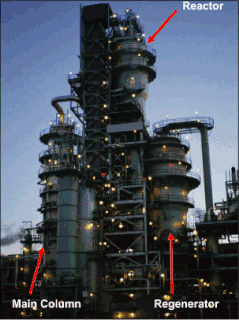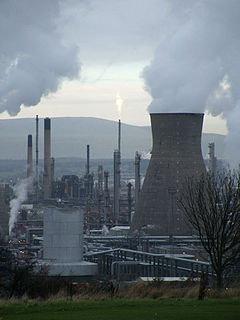
Atomic absorption spectroscopy (AAS) and atomic emission spectroscopy (AES) is a spectroanalytical procedure for the quantitative determination of chemical elements using the absorption of optical radiation (light) by free atoms in the gaseous state. Atomic absorption spectroscopy is based on absorption of light by free metallic ions.

Vanadium is a chemical element with symbol V and atomic number 23. It is a hard, silvery-grey, ductile, malleable transition metal. The elemental metal is rarely found in nature, but once isolated artificially, the formation of an oxide layer (passivation) somewhat stabilizes the free metal against further oxidation.
The unified atomic mass unit or dalton is a standard unit of mass that quantifies mass on an atomic or molecular scale. One unified atomic mass unit is approximately the mass of one nucleon and is numerically equivalent to 1 g/mol. It is defined as one twelfth of the mass of an unbound neutral atom of carbon-12 in its nuclear and electronic ground state and at rest, and has a value of 1.660539040(20)×10−27 kg, or approximately 1.66 yoctograms. The CIPM has categorised it as a non-SI unit accepted for use with the SI, and whose value in SI units must be obtained experimentally.

A lighter is a portable device used to create a flame, and to ignite a variety of combustible materials, such as cigars, gas stoves, fireworks, candles or cigarettes. It consists of a metal or plastic container filled with a flammable fluid or pressurized liquid gas, a means of ignition to produce the flame, and some provision for extinguishing the flame. Alternatively, a lighter can be powered by electricity, using an electric arc or heating element to ignite the target.

Liquefied petroleum gas or liquid petroleum gas, also referred to as simply propane or butane, are flammable mixtures of hydrocarbon gases used as fuel in heating appliances, cooking equipment, and vehicles.

Fuel oil is a fraction obtained from petroleum distillation, either as a distillate or a residue. In general terms, fuel oil is any liquid fuel that is burned in a furnace or boiler for the generation of heat or used in an engine for the generation of power, except oils having a flash point of approximately 42 °C (108 °F) and oils burned in cotton or wool-wick burners. Fuel oil is made of long hydrocarbon chains, particularly alkanes, cycloalkanes and aromatics. The term fuel oil is also used in a stricter sense to refer only to the heaviest commercial fuel that can be obtained from crude oil, i.e., heavier than gasoline and naphtha.

Group 5 is a group of elements in the periodic table. Group 5 contains vanadium (V), niobium (Nb), tantalum (Ta) and dubnium (Db). This group lies in the d-block of the periodic table. The group itself has not acquired a trivial name; it belongs to the broader grouping of the transition metals.

Nuclear fission products are the atomic fragments left after a large atomic nucleus undergoes nuclear fission. Typically, a large nucleus like that of uranium fissions by splitting into two smaller nuclei, along with a few neutrons, the release of heat energy, and gamma rays. The two smaller nuclei are the fission products..

Elemental analysis is a process where a sample of some material is analyzed for its elemental and sometimes isotopic composition. Elemental analysis can be qualitative, and it can be quantitative. Elemental analysis falls within the ambit of analytical chemistry, the set of instruments involved in deciphering the chemical nature of our world.

Vanadium(V) oxide (vanadia) is the inorganic compound with the formula V2O5. Commonly known as vanadium pentoxide, it is a brown/yellow solid, although when freshly precipitated from aqueous solution, its colour is deep orange. Because of its high oxidation state, it is both an amphoteric oxide and an oxidizing agent. From the industrial perspective, it is the most important compound of vanadium, being the principal precursor to alloys of vanadium and is a widely used industrial catalyst.

Petroleum coke, abbreviated coke or petcoke, is a final carbon-rich solid material that derives from oil refining, and is one type of the group of fuels referred to as cokes. Petcoke is the coke that, in particular, derives from a final cracking process—a thermo-based chemical engineering process that splits long chain hydrocarbons of petroleum into shorter chains—that takes place in units termed coker units. Stated succinctly, coke is the "carbonization product of high-boiling hydrocarbon fractions obtained in petroleum processing ." Petcoke is also produced in the production of synthetic crude oil (syncrude) from bitumen extracted from Canada’s oil sands and from Venezuela's Orinoco oil sands.
Graphite furnace atomic absorption spectroscopy (GFAAS) is a type of spectrometry that uses a graphite-coated furnace to vaporize the sample. Briefly, the technique is based on the fact that free atoms will absorb light at frequencies or wavelengths characteristic of the element of interest. Within certain limits, the amount of light absorbed can be linearly correlated to the concentration of analyte present. Free atoms of most elements can be produced from samples by the application of high temperatures. In GFAAS, samples are deposited in a small graphite or pyrolytic carbon coated graphite tube, which can then be heated to vaporize and atomize the analyte. The atoms absorb ultraviolet or visible light and make transitions to higher electronic energy levels. Applying the Beer-Lambert law directly in AA spectroscopy is difficult due to variations in the atomization efficiency from the sample matrix, and nonuniformity of concentration and path length of analyte atoms. Concentration measurements are usually determined from a working curve after calibrating the instrument with standards of known concentration.
The main advantages of the graphite furnace comparing to aspiration atomic absorption are the following:
Naturally occurring vanadium (23V) is composed of one stable isotope 51V and one radioactive isotope 50V with a half-life of 1.5×1017 years. 24 artificial radioisotopes have been characterized (in the range of mass number between 40 and 65) with the most stable being 49V with a half-life of 330 days, and 48V with a half-life of 15.9735 days. All of the remaining radioactive isotopes have half-lives shorter than an hour, the majority of them below 10 seconds, the least stable being 42V with a half-life shorter than 55 nanoseconds, with all of the isotopes lighter than it, and none of the heavier, have unknown half-lives. In 4 isotopes, metastable excited states were found (including 2 metastable states for 60V), which adds up to 5 meta states.
Asphaltenes are molecular substances that are found in crude oil, along with resins, aromatic hydrocarbons, and saturates. The word "asphaltene" was coined by Boussingault in 1837 when he noticed that the distillation residue of some bitumens had asphalt-like properties. Asphaltenes in the form of asphalt or bitumen products from oil refineries are used as paving materials on roads, shingles for roofs, and waterproof coatings on building foundations.

Fluid catalytic cracking (FCC) is one of the most important conversion processes used in petroleum refineries. It is widely used to convert the high-boiling, high-molecular weight hydrocarbon fractions of petroleum crude oils into more valuable gasoline, olefinic gases, and other products. Cracking of petroleum hydrocarbons was originally done by thermal cracking, which has been almost completely replaced by catalytic cracking because it produces more gasoline with a higher octane rating. It also produces byproduct gases that have more carbon-carbon double bonds, and hence more economic value, than those produced by thermal cracking.

Petron Corporation is the largest oil refining and marketing company in the Philippines, supplying more than a third of the country’s oil requirements. It operates a refinery in Limay, Bataan, with a rated capacity of 180,000 barrels per day (29,000 m3/d). From the refinery, Petron moves their products mainly by sea to 32 depots and terminals in the country. They operate a lube oil blending plant at their Pandacan Terminal, where it manufactures lubes and greases.

The Indian Institute of Petroleum (IIP), established in 1960, is one of the constituent laboratories of the Council of Scientific and Industrial Research (CSIR), dedicated to R&D in the hydrocarbon sector.
Ashing is a test to deduce the amount of ash forming material present in a petroleum product so as to decide its use in certain applications. Ash-forming materials are considered to be undesirable impurities or contaminants.
The environmental impact of biodiesel is diverse.
Marine Diesel Oil (MDO) is a type of fuel oil and is a blend of gasoil and heavy fuel oil, with less gasoil than intermediate fuel oil used in the maritime field. Marine Diesel Oil is also called "Distillate Marine Diesel". MDO is widely used by medium speed and medium/high speed marine diesel engines. It is also used in the larger slow speed and medium speed propulsion engine which normally burn residual fuel. Those fuels result from a catalytic cracking/visbreaking refinery. Marine diesel oil has been condemned for its nimiety of sulfur, so many countries and organizations established regulations and laws on MDO use. Due to its lower price compared to more refined fuel, MDO is favored particularly by shipping industry.













